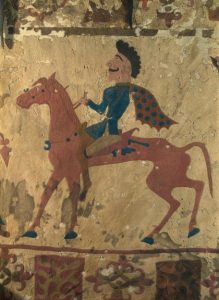Mounted Warrior from the Altai, Pazyryk-Culture
4./3. Century BC d. Z.

The Pazyryk culture once located in the area of today’s Altai Mountains, apparently consisted of various cultural areas. Therefore, the different clothing styles have similarities, but also show peculiarities in detail. The tombs of Pazyryk were well known for their permafrost preserved findings, among which were many objects made of organic materials (textile, leather, wood, horn, …). The presentation shown here is dated in the late 5th and 4th century BC. Except for the headgear, all the components were displayed on a felt tapestry in the eponymous tomb Pazyryk 5. In the Pazyryk burial mounds the elite of the nomads of the Altai was buried. The burial chamber of the Kurgan 5 was decorated with a felt drapery depicting repeatedly the image of a rider on horseback facing a deity (?) – one of the rare portrayals of people from the material culture of the Pazyryk culture. Whether the individual components were ever worn in this combination is unclear. Since representations of the Pazyryk culture usually took only such finds into account, in which a precise combination of clothing and equipment was directly found in the burial in unambiguous combination, other finds and grave goods were given little attention. In mind are usually only those representations, e.g. be published and distributed by graphic reconstructions. Taking into account the existing garments and possible variants, the collection shown here allows a further new perspective on the fashion of the Pazyryk culture and counteracts the false impression of alleged uniformity or similarity in the clothing of the ancient nomads.
Go to the equipment details.


